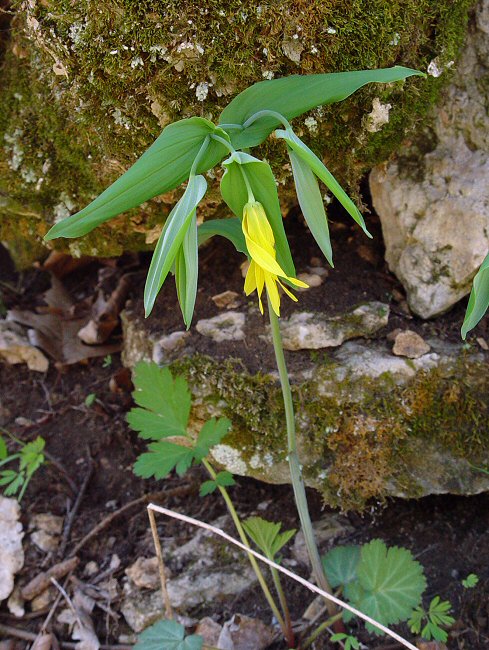Uvularia grandiflora Sm.
Large Bellwort

Native
CC = 6
CW = 5
MOC = 72
© DETenaglia
Uvularia grandiflora Sm.Large Bellwort | |
 |
Native CC = 6 CW = 5 MOC = 72 |
© DETenaglia |
|
Family - Liliaceae Habit - Rhizomatous perennial forb. Stems - Erect, to 70 cm, hollow, usually branched into two forks above, usually arched near the tip, glabrous, glaucous.
Leaves - Alternate, the basal few reduced to bladeless sheaths, the remainder perfoliate, 0-2 normal leaves below the fork, several above the fork, rounded at base, acute at apex, entire, with 3-5 prominent parallel veins, somewhat lighter colored and sparsely to densely and minutely pubescent on the undersurface.
Inflorescence - Single flowers at the tips of short, axillary branches with 0 or 1 leaves, appearing axillary. Pedicel to 1.5cm long, glabrous. Flowers pendent.
Flowers - Flower stalks 7-30 mm long. Perianth bell-shaped, the 6 tepals free, 2.5-5.0 cm long, linear to narrowly elliptic or narrowly oblanceolate, often spirally twisted, pale yellow to yellow. Stamens 6, free, the filaments compressed, 5 mm long, white, glabrous, the anthers 1.6 cm long, yellow. Style 3-lobed, connate in basal half, each narrow lobe with a linear stigmatic area on the inner surface near the tip. Ovary superior, sometimes short-stalked, with 3 locules, each with 2-6 ovules. Placentation axile.
Fruits - Obovoid 3-lobed capsules 8-15 mm long, the tip broadly rounded to nearly straight across, the angles not winged.
Flowering - April - May. Habitat - Forests, shaded slopes, ravines, streambanks. Origin - Native to the U.S. Lookalikes - U. sessilifolia. Vegetatively the plant resembles Polygonatum biflorum and Maianthemum spp. Other info. - This striking species is common throughout most of Missouri except in some of the prairie regions. Its broader range includes most of the U.S. Midwest and parts of Canada. This species is one of the earlier plants to bloom in the spring. The perfoliate leaves, sometimes appearing as if sewn together by the stem, differentiate this plant from its closest lookalikes listed above. Photographs taken at Rock Bridge State Park, Columbia, MO., 4-18-04 (DETenaglia); also at Weldon Spring Conservation Area, St. Charles County, MO, 4-21-2008, Little Lost Creek Conservation Area, Warren County, MO, 4-25-2014, and near Labadie, Franklin County, MO, 7-21-2009 (SRTurner); also on 6-28-2019 (KBildner). |